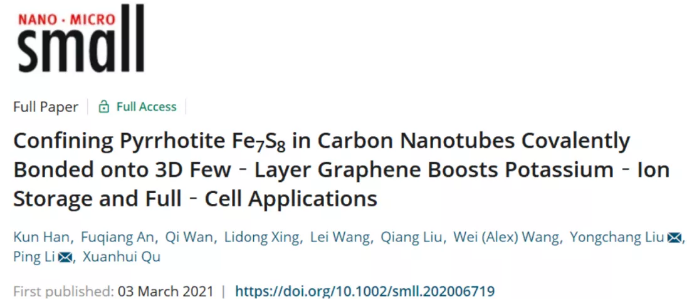
Author: Han Kun
Corresponding author: Li Ping, Liu Chang
Correspondence Unit: University of Science and Technology Beijing
【Research Background】
The increasing cost of lithium-ion batteries and the continuous consumption of lithium resources have made lithium-ion batteries unable to meet the needs of large-scale energy storage applications. Sodium and potassium, the alkali metal elements of the same family as lithium, are undoubtedly the most attractive. Compared with sodium, potassium has some unique advantages (such as lower standard electrode potential and smaller solvation), which promotes potassium ion batteries. It has become another research hotspot after sodium ion battery, and it has developed rapidly in recent years. Among all kinds of electrode materials, iron-based metal sulfide anode materials with a wide range of sources, low cost and high theoretical specific capacity have attracted much attention, especially Pyrrhotite Fe7S8 is rich in mixed Fe valence states and has high conductivity, and is charged and discharged. The plateau is low, but the stress caused by the extraction/intercalation of potassium ions during the cycle will cause structural damage to the electrode material; in addition, the potassium storage mechanism of Pyrrhotite Fe7S8 is still unknown. Therefore, it is of great significance to improve the cycle stability of Pyrrhotite Fe7S8 and to deeply understand the electrochemical reaction mechanism between potassium ions and electrode materials.
【Introduction to Achievements】
Recently, researchers from the team of Professor Qu Xuanhui from University of Science and Technology Beijing, Professor Li Ping and Professor Liu Yongchang, used chemical foaming and CVD strategies to design and fabricate a covalently connected three-dimensional graphene/carbon nanotube confined Pyrrhotite Fe7S8 hierarchical structure (Fe7S8@CNT@3DFG) Promote efficient and stable storage of potassium ions, and combined with in-situ/ex-situ characterization methods to systematically explain the reaction mechanism between potassium ions and Pyrrhotite Fe7S8. This work was published in Small as a research paper entitled "Confining Pyrrhotite Fe7S8 in Carbon Nanotubes Covalently Bonded onto 3D Few-Layer Graphene Boosts Potassium-Ion Storage and Full-Cell Applications".
【Research Highlights】
1. The three-dimensional graphene/carbon nanotube confined Pyrrhotite Fe7S8 hierarchical structure covalently connected by chemical foaming and CVD strategies, in which the porous structure of the three-dimensional graphene (3DFG) can grow confined carbon nanotubes (CNT) Avoid agglomeration, and carbon nanotubes can further confine Pyrrhotite Fe7S8 nanoparticles to buffer volume expansion while avoiding particle agglomeration. In addition, the CNT@3DFG covalent structure can serve as a three-dimensional conductive network to promote electronic and ion conduction.
2. Fe3C dual-functional catalysis: 1) It can catalyze the formation of 3DFG during the chemical foaming process; 2) It can catalyze the growth of CNTs from the graphene surface in the top growth mode during CVD.
3. The electrochemical potassium storage mechanism of Pyrrhotite Fe7S8 was systematically explained by in-situ/ex-situ characterization methods: the highly reversible potassium ion extraction and intercalation process and partial conversion reaction mechanism.
[Core graphic]
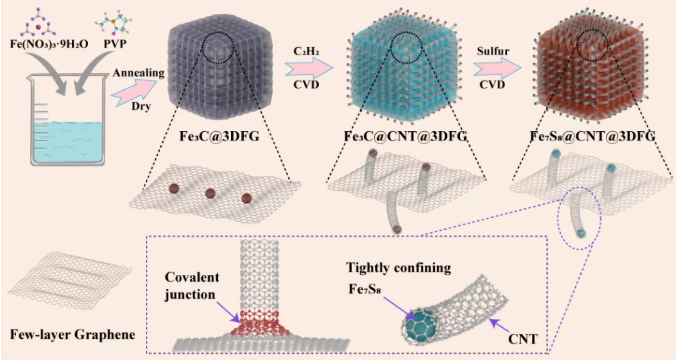
Figure 1. Synthesis diagram of Fe7S8@CNT@3DFG.
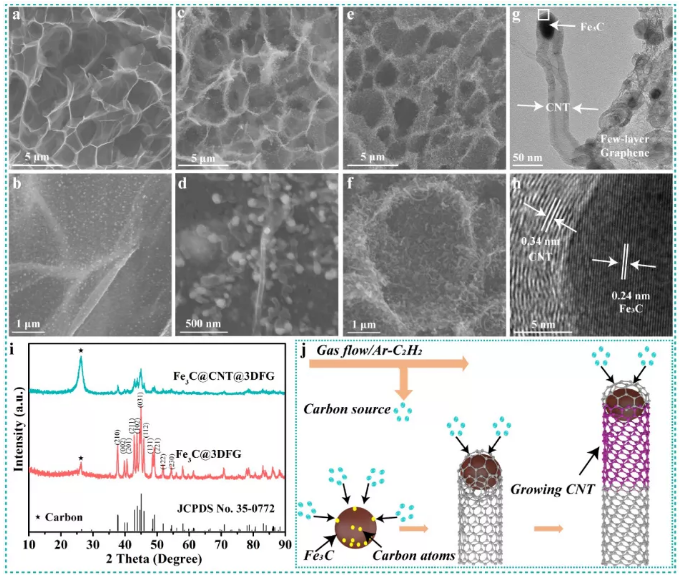
Figure 2. Process study of Fe3C catalyzed CNT growth. (Ab) SEM image of Fe3C @3DFG, (cd) Fe3C @3DFG SEM image of 5min CNT growth, (ef) Fe3C @CNT@3DFG SEM image (growth 15min CNT), (gh) Fe3C @CNT@3DFG TEM and HRTEM images, (i) XRD comparison before and after CNT growth, (j) Schematic diagram of the process of Fe3C catalyzed CNT growth.
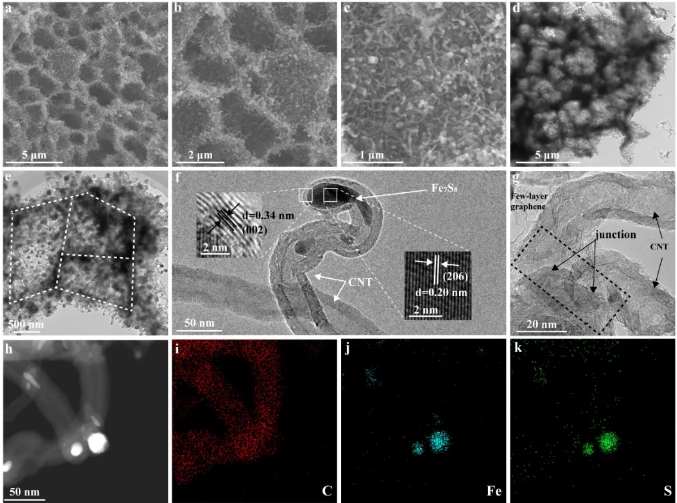
Figure 3. The morphology characterization of Fe7S8@CNT@3DFG. (A-c) SEM images. (D-e) TEM image, (f-g) HRTEM image. (H-k) HAADF-STEM images and element mappings.
image
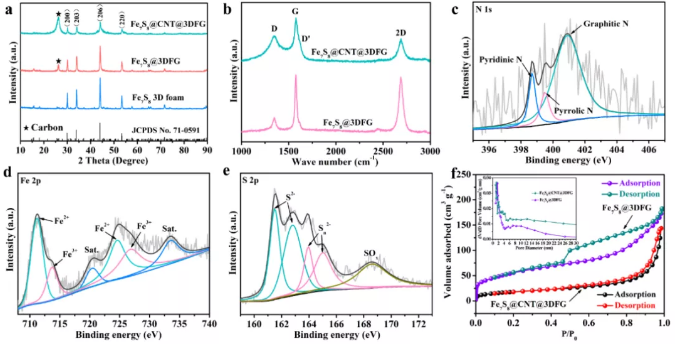
Figure 4. (a) Fe7S8 3D foam, XRD of Fe7S8@3DFG and Fe7S8@CNT@3DFG, (b) Raman of Fe7S8@3DFG and Fe7S8@CNT@3DFG, (ce) high-resolution XPS of Fe7S8@CNT@3DFG Spectrum, (f) Nitrogen adsorption and desorption curves and pore size distribution diagrams of Fe7S8@3DFG and Fe7S8@CNT@3DFG.

Figure 5. (a) CV curve of Fe7S8@CNT@3DFG electrode, (b) charge and discharge curve of Fe7S8@CNT@3DFG, (c) cycle performance of Fe7S83D foam, Fe7S8@3DFG and Fe7S8@CNT@3DFG electrodes, ( d) Rate charge-discharge curve of Fe7S8@CNT@3DFG, (e) rate cycle performance of Fe7S8 3D foam, Fe7S8@3DFG and Fe7S8@CNT@3DFG electrodes, (f) rate performance of Fe7S8@CNT@3DFG electrode and reported in the literature Comparison of some negative materials.
image

Figure 6. (a-c) In-situ XRD patterns of Fe7S8 3D foam electrode, (d) Ex-situ high-resolution Fe 2p XPS of Fe7S8 3D foam electrode, (e) Schematic diagram of electrochemical potassium storage mechanism of Fe7S8

Figure 7. (a) Schematic diagram of potassium ion full battery based on Prussian blue analog positive electrode (KPB) and Fe7S8@CNT@3DFG negative electrode, (b) charge and discharge curves of KPB positive electrode and Fe7S8@CNT@3DFG negative electrode, (c) KPB //Fe7S8@CNT@3DFG Potassium ion full battery charge and discharge curve, (d) full battery cycle performance
Kun Han, Fuqiang An, Qi Wan, Lidong Xing, Lei Wang, Qiang Liu, Wei (Alex) Wang, Yongchang Liu,* Ping Li,* Xuanhui Qu, Confining Pyrrhotite Fe7S8 in Carbon Nanotubes Covalently Bonded onto 3D Few‐Layer Graphene Boosts Potassium-Ion Storage and Full-Cell Applications. Small, 2021, DOI: 10.1002/smll.202006719










